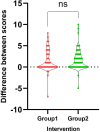Effectiveness of Group and Individual Counselling Interventions on COVID-19 Vaccination Intention Among Industrial Employees in Romania
- PMID: 40201013
- PMCID: PMC11977631
- DOI: 10.2147/PPA.S500640
Effectiveness of Group and Individual Counselling Interventions on COVID-19 Vaccination Intention Among Industrial Employees in Romania
Abstract
Introduction: Vaccine hesitancy remains a critical barrier to achieving widespread vaccination, particularly in settings with limited public trust and high exposure to misinformation. This study aims to measure the level of vaccine hesitancy, identifying the factors contributing to it, and to evaluate the effectiveness of two targeted interventions-group and individual counseling-designed to address vaccine hesitancy among employees in seven industrial companies in Romania during the Coronavirus disease 2019 (COVID-19) pandemics.
Methods: A total of 256 participants were included in the study, and interventions were delivered by family physicians and occupational medicine specialists trained in motivational interviewing (MI) techniques. Data on sociodemographic factors, vaccine hesitancy, and willingness to vaccinate were collected using a questionnaire and a Visual Analogue Scale (VAS) for vaccine willingness.
Results: Both interventions led to significant increases in willingness to vaccinate, with group counseling showing a 1.4-point increase on the VAS (p-value < 0.0001) and individual counseling showing a 1.5-point increase (p-value < 0.0001), though the differences between the two approaches were not statistically significant (p-value = 0.209). Key factors correlated with higher levels of vaccine hesitancy included younger age, lower education levels, marital status (single or divorced), having children, the presence of chronic diseases, a lack of general antivaccine beliefs, and a lack of trust in the natural origin of the novel coronavirus (SARS-CoV-2).
Conclusion: This study highlights the effectiveness of dual interventions involving family doctors and occupational medicine specialists in reducing COVID-19 vaccine hesitancy among industrial workers in Romania. Key factors influencing hesitancy included demographic characteristics (age, marital status) and social determinants (education level, anti-vaccine beliefs, parenthood, and chronic illness). The findings emphasize the role of trusted healthcare professionals in addressing these concerns through targeted communication strategies, such as motivational interviewing.
Keywords: COVID-19 vaccine; Romania; motivational interview; questionnaire; vaccine hesitancy; workers.
© 2025 Dumitra et al.
Conflict of interest statement
The authors declare no conflicts of interest in this work.
Figures



Similar articles
-
SARS-CoV-2 variants and the global pandemic challenged by vaccine uptake during the emergence of the Delta variant: A national survey seeking vaccine hesitancy causes.J Infect Public Health. 2022 Jul;15(7):773-780. doi: 10.1016/j.jiph.2022.06.007. Epub 2022 Jun 17. J Infect Public Health. 2022. PMID: 35728424 Free PMC article.
-
Addressing vaccine hesitancy and resistance for COVID-19 vaccines.Int J Nurs Stud. 2022 Jul;131:104241. doi: 10.1016/j.ijnurstu.2022.104241. Epub 2022 Apr 1. Int J Nurs Stud. 2022. PMID: 35489108 Free PMC article. Review.
-
COVID-19 vaccine hesitancy, trust, and communication in Sarlahi District, Nepal.Vaccine. 2024 Nov 14;42 Suppl 5:126034. doi: 10.1016/j.vaccine.2024.06.002. Epub 2024 Jun 10. Vaccine. 2024. PMID: 38862309
-
Vaccine Attitudes and COVID-19 Vaccine Intention Among Parents of Children With Kidney Disease or Primary Hypertension.Am J Kidney Dis. 2023 Jan;81(1):25-35.e1. doi: 10.1053/j.ajkd.2022.04.011. Epub 2022 Jun 21. Am J Kidney Dis. 2023. PMID: 35750280 Free PMC article.
-
Interventions to increase COVID-19 vaccine uptake: a scoping review.Cochrane Database Syst Rev. 2022 Aug 3;8(8):CD015270. doi: 10.1002/14651858.CD015270. Cochrane Database Syst Rev. 2022. PMID: 35920693 Free PMC article.
Cited by
-
Parental hesitancy on COVID-19 vaccination of children under the age of 16: A cross-sectional mixed-methods study among factory workers.PLoS One. 2025 Jun 26;20(6):e0327056. doi: 10.1371/journal.pone.0327056. eCollection 2025. PLoS One. 2025. PMID: 40569977 Free PMC article.
References
-
- Duta TF, Rizki DR, Purnama A, et al. Essential oil for COVID-19 management: a systematic review of randomized controlled trials. Narra X. 2023;1(2):e93. doi:10.52225/narrax.v1i2.84 - DOI
-
- COVID-19 vaccines | WHO COVID-19 dashboard. Datadot. Available from: https://data.who.int/dashboards/covid19/vaccines?m49=642&n=o. Accessed July 27, 2024).
-
- COVID-19 Vaccine Tracker | European Centre for Disease Prevention and Control. Available from: https://vaccinetracker.ecdc.europa.eu/public/extensions/COVID-19/vaccine.... Accessed July 27, 2024).
LinkOut - more resources
Full Text Sources
Miscellaneous

